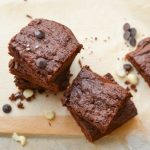4 reasons calorie counting doesn’t work

For decades, conventional wisdom has taught that all calories are made equal. If you want to lose weight, doctors, dieticians, and scientists alike have taught that you simply need to burn more calories than you consume. Move more, eat less. Formulas abound trying to predict how many calories a certain body needs to lose a certain number of pounds a week. If you “need” 1800 calories a day, these formulas will tell you to limit yourself to just 1300 calories a day to lose a pound a week…or be sure to “burn” those excess calories exercising (and figuring out how much exercise burns how many calories is its own formula).
It seems like simple math.
A lot of people have lost weight on the “Calorie in, calorie out” (or CICO) method.
And a lot of people have gained it all back, plus interest.
In recent years, studies overwhelmingly have shown that the calorie-counting method is deeply flawed, yet many cling to the outdated notion that counting calories will solve their diet woes.
Let’s review some reasons why counting calories doesn’t work…and then look at what does.
1. Low Calorie Diets Lead to “Starvation Mode”
Calorie-restricted diets create a cascade of effects throughout the body that lead to metabolic inefficiency, a process known as metabolic adaptation. The greater the calorie deficit, the greater the inefficiency. Multiple systems in the body strenuously fight to return to and maintain the higher weight. Some people refer to this as “starvation mode.”
Contrary to popular belief, as a person loses weight, their metabolic rate actually slows. Smaller bodies don’t have to work as hard to function as they did at a greater weight. Compounding this problem is the fact that, as weight is lost, appetite actually increases over the former baseline. Thus, not only does someone focusing on calories have to remain at a permanently lower caloric intake to maintain a now smaller weight, they have to do so even hungrier than before.
2. Low Calorie Diets Lead to Yo-Yo Dieting
As mentioned above, calorie restriction slows an individual’s metabolic rate. When the metabolic rate is slowed, a person has less fuel available for the many functions the body requires, leaving the person with less energy and more hunger. Because the body is now using less energy in spite of the lower caloric intake, weight loss stalls. In frustration, many people resume their previous diet but with a lower metabolic weight. This leads to them regaining their lost weight, and often more. This pattern of losing and gaining weight is known as the yo-yo effect.
3. Caloric Quality > Caloric Quantity
Whenever we eat anything, our bodies work to break it down, meaning that our metabolic “rate” increases during that time period. The body has to work harder to break down protein than it has to for carbohydrates (which convert to glucose in the body). If the body uses more energy to digest a steak than it does to digest the same number of calories in apples (let alone something like cake), obviously those two calories are not, in fact, equal. Even carbohydrates are digested at different rates, thereby creating different metabolic outcomes. Simple carbs like potatoes, pasta, and candy digest quickest, causing more rapid increases in blood sugar. Meanwhile, complex carbs like quinoa or leafy greens take longer for the body to break down, making the impact on blood sugar and insulin steadier and more moderate. Protein takes longer still, driving metabolic rate higher thanks to the thermic effect of food.
4. Hormones, hormones, hormones
…insulin, leptin, and ghrelin, to name a few. Each of these hormones responds differently to different foods. The simpler the carbohydrate, the more rapidly it’s digested and absorbed, creating a dramatic spike in blood glucose. That spike sets off a chain reaction throughout the body.
Insulin – The digestive system breaks down any digestible (non-fiber) carbs into sugar. That sugar enters the bloodstream and tells the pancreas to release insulin. Insulin then instructs the body to use some of that sugar in the bloodstream as immediate energy, but it tells the rest to be stored as fat throughout the body. For insulin sensitive people, only a small amount of insulin is necessary to keep this essential process happening. But the more a body is subjected to a hormone, the more resistant it becomes to it. As an individual keeps eating carbohydrates, the body produces more and more insulin, which in turn leads to more and more stored fat.
Let’s look at fat and protein. By itself, pure dietary fat has virtually no impact on insulin, whereas protein causes an insulin increase. However, there are some key features that diminish the impact of protein on potential fat storage. First, the insulin increase that follows protein is slower and more sustained than the increase that follows even complex carbohydrates, meaning that not as much insulin is required at one time (thereby preventing insulin resistance). Second, in healthy non-diabetic people, insulin and glucagon are released after high protein meals. Glucagon further regulates blood sugar, lessening the impact of insulin. Third, when protein is digested, it doesn’t just provide energy or fat storage; protein’s primary function is to repair and build cells. Digestion breaks down protein into amino acids that are sent throughout the body to perform these necessary functions.
Put simply, while protein will elicit an insulin response, 1000 calories of egg whites will not lead to the same fat storage as 1000 calories of bananas.
Ghrelin – In the presence of any food, the hunger hormone ghrelin is temporarily suppressed. After eating simple carbs, however, ghrelin markedly rises after only two hours, and it rises even above where it had been, leaving you hungrier than before. By contrast, when fat is consumed, ghrelin stays low for about four hours and only then begins its more gradual climb. Protein also keeps ghrelin (hunger) low longer than carbohydrates will.
In other words, carb heavy snacks and meals lead to greater and more constant hunger than an equivalent amount of fat and/or protein. Calories don’t tell the whole story.
Leptin – Leptin is the hormone of satiety, or satisfaction. Eating carbohydrate-heavy meals will release more leptin than fat-heavy or protein-heavy meals will. On the surface, this sounds like a good thing, right? Carbs lead to greater satisfaction!
Not quite.
Leptin is released from fat cells. Thus as a body starts gaining more and more fat, leptin levels continue to climb. This quickly becomes problematic, because as already established, when the body is inundated with a hormone, it becomes resistant to that hormone. In the case of leptin resistance, with so much leptin released from fat cells, the hypothalamus will essentially ignore the hormone. The brain then misses the signal to stop eating, which contributes to further weight gain, which leads to even more fat cells releasing leptin, and so on.
Interestingly, while more leptin is not released by eating protein, what does increase is self-reported satiety, even with isocaloric meals.
The takeaway? Calorie for calorie, protein leads to increased satiety without the same risk of leptin resistance as carbohydrates.
Now that you’ve seen evidence that calories are not the whole story with weight loss, let’s look at what actually works.
Focus on Nutrition
Calorie for calorie, protein and fat eaten together will lead to the greatest balance of satisfaction and hunger-suppression with the least amount of fat storage. Diets that combine these macronutrients and restrict carbohydrates without restricting calories include the ketogenic diet, low carb diet, carnivore diet, and Mediterranean diet.
You don’t have to be hungry to lose weight. You just have to eat smart.
References
- Rosenbaum M, Leibel RL. Adaptive thermogenesis in humans. Int J Obes (Lond). 2010 Oct;34 Suppl 1(0 1):S47-55. doi: 10.1038/ijo.2010.184. PMID: 20935667; PMCID: PMC3673773.
- Polidori D, Sanghvi A, Seeley RJ, Hall KD. How Strongly Does Appetite Counter Weight Loss? Quantification of the Feedback Control of Human Energy Intake. Obesity (Silver Spring) 2016;24(11):2289–2295.
- Hasek LY, Phillips RJ, Hayes AMR, Kinzig K, Zhang G, Powley TL, Hamaker BR. Carbohydrates designed with different digestion rates modulate gastric emptying response in rats. Int J Food Sci Nutr. 2020 Nov;71(7):839-844. doi: 10.1080/09637486.2020.1738355. Epub 2020 Mar 11. PMID: 32157931; PMCID: PMC7895304.
- Reed GW, Hill JO. Measuring the thermic effect of food. Am J Clin Nutr. 1996 Feb;63(2):164-9. doi: 10.1093/ajcn/63.2.164. PMID: 8561055.
- Radulescu A, Gannon MC, Nuttall FQ. The effect on glucagon, glucagon-like peptide-1, total and acyl-ghrelin of dietary fats ingested with and without potato. J Clin Endocrinol Metab. 2010 Jul;95(7):3385-91. doi: 10.1210/jc.2009-2559. Epub 2010 May 5. PMID: 20444922; PMCID: PMC3213865.
- Blom WA, Lluch A, Stafleu A, Vinoy S, Holst JJ, Schaafsma G, Hendriks HF. Effect of a high-protein breakfast on the postprandial ghrelin response. Am J Clin Nutr. 2006 Feb;83(2):211-20. doi: 10.1093/ajcn/83.2.211. PMID: 16469977.
- https://www.frontiersin.org/articles/10.3389/fendo.2021.749050/full
This article is for informational and educational purposes only. It is not, nor is it intended to be substitute for professional medical advice, diagnosis, or treatment and should never be relied upon for specific medical advice.


















